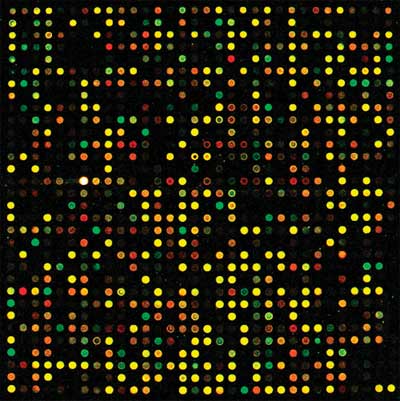 The traditional methods of generating protein arrays require the separate expression of hundreds of proteins, followed by purification and immobilization of the proteins on a solid surface. Cell-Free protein array technology produces protein microarrays by performing in vitro synthesis of the target protein from their DNA templates.
The traditional methods of generating protein arrays require the separate expression of hundreds of proteins, followed by purification and immobilization of the proteins on a solid surface. Cell-Free protein array technology produces protein microarrays by performing in vitro synthesis of the target protein from their DNA templates.
One approach for the generation of cell- free based microarrays is the nucleic acid programmable protein array (NAPPA).
NAPPA uses DNA template that is biotinylated and is bound to avidin that is pre-coated onto the protein capture surface. Newly synthesized proteins which are tagged with GST are then immobilized next to the template DNA by binding to an adjacent polyclonal anti-GST capture antibody. The following references illustrate the use of NAPPA to screen hundreds of proteins.
Wright, C. et al. (2011) Mol.Cell. Biol. (in press). To determine the extent of autoantibodies expression in ankylosing spondylitis, AS (a common inflammatory disease) plasmid DNA representing 3498 proteins was arrayed and expressed then screened against with sera from patients with anklosing spondylitis and healthy controls. Results indicated that AS patients’ auto response were targeted towards connective, skeletal and muscular tissue
Anderson, K. et al. (2010) J. Proteomics Res. 10, 85-96. 4988 ORF candidate tumor antigens were arrayed as plasmid DNA and proteins expressed and capture on a protein microarray using the NAPAA technology. Replicate arrays were probed with sera from patients with breast cancer and healthy controls. In conjunction with other assays a panel of 28 biomarkers were determined.
Motor, W et.al. (2009) Infection Immun. 77, 4877-86. A comprehensive study of 266 gene products of are among the 5570 ORFs of Psuedmonas aeruginosa that were likely to reside in the outer membrane or secreted into the surrounding media were screened (using the NAPPA technology) for their antigenicity. From this study it was possible to identify 12 proteins that trigger an adaptive immune response in cystic fibrosis and acutely infected patients.
Rolf, A. et al. (2008) Proc. Natl. Acad. Sci. 105, 4364–69. In this reference they report the assembly of a complete ORF collection (3887) for V. cholerae. Fifteen percent of this collection was transferred into relevant GST expression vectors and arrayed as plasmid DNA and subsequently expressed using the Promega TNT system. The resulting proteins were screen to determine if they triggered a Toll-like recpetors (TLR) using A549 cells containing a luciferase gene transcribed under control of a NF-kB response promoter. Using this approach a novel TLR5 agonist (FlaC) was characterized.

Protein arrays are rapidly becoming established as a powerful means to detect proteins, monitor their expression levels, and investigate protein interactions and functions. They are seeing an explosive progress and interest at the moment and have become one of the most active areas emerging in biotechnology today. Thanks a lot!